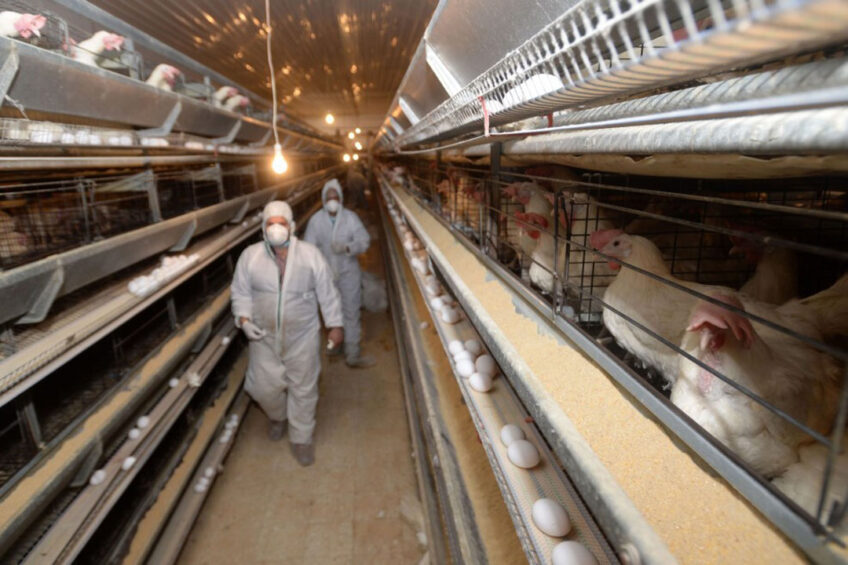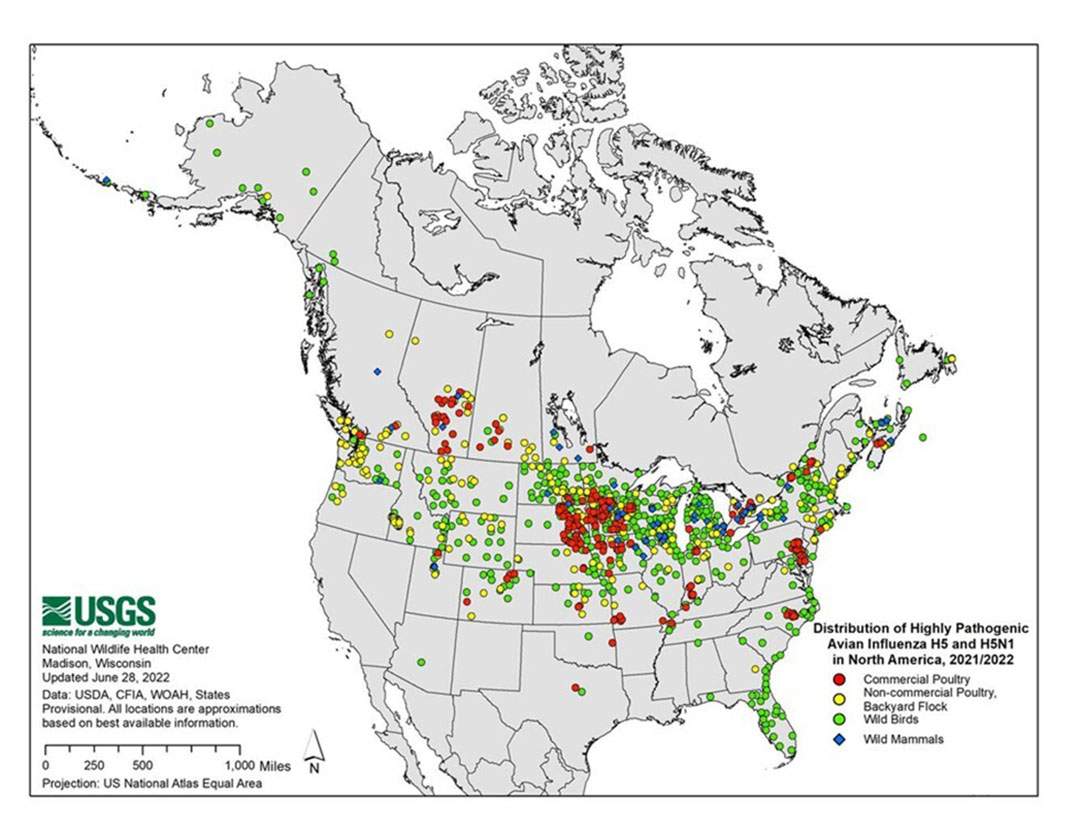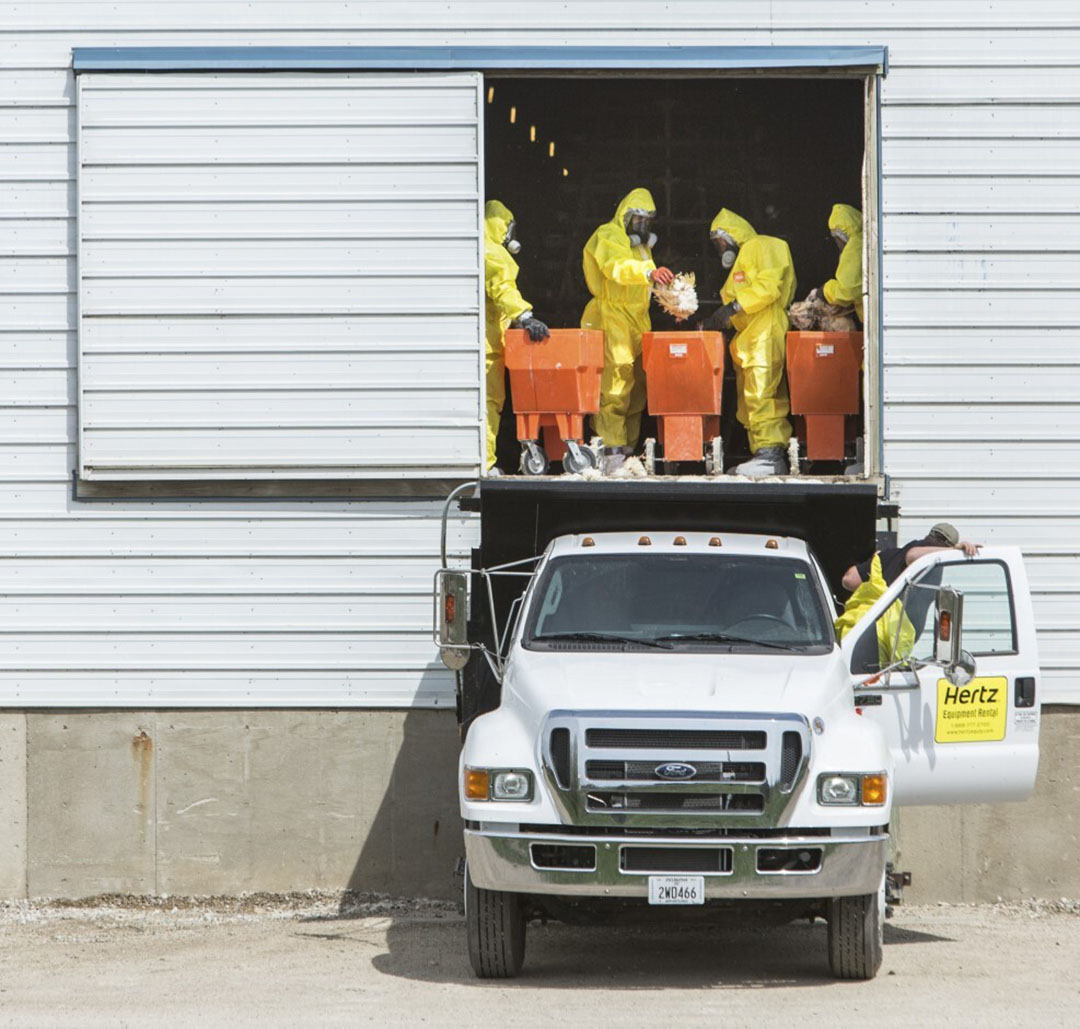Analysing the 2022 US avian influenza outbreak

From February to June 2022, the US battled a massive outbreak of avian influenza. In total, 186 cases were reported resulting in the loss of 40.1 million birds. Lessons learned during the 2015 outbreak were clearly not remembered during the 7-year hiatus without a major incident.
In 2016, the Animal and Plant Health Inspection Service (APHIS) of the US Department of Agriculture stated in its final report on the 2015 epidemic that these were the most serious outbreaks ever in the US. A total of 227 outbreaks of the highly pathogenic influenza virus were recorded, killing 50.4 million poultry, including 43 million laying hens and 7.4 million turkeys.
According to an analysis by Böckmann (2021), the overall economic damage was over US$ 3 billion. In the 5 years that followed, only minor outbreaks occurred which could be brought quickly under control. Between February and June 2022 there were again massive outbreaks of the virus. In total, 186 cases were documented, resulting in the loss of 40.1 million birds in commercial herds. Although the 2 epidemics occurred in almost the same time periods in 2015 and 2022, they showed significant differences, as comparisons will show.
The time period of the outbreaks
The first outbreak of the H5N1 virus strain was detected on 8 February 2022 in a turkey farm in Indiana. More cases emerged in the days that followed. Almost simultaneously, farms in Kentucky were infected – a turkey and a broiler grower. In late February and early March, additional outbreaks occurred in layer and broiler flocks in Delaware and Maryland, and on a broiler farm in Missouri.
From mid-March, several large layer flocks in Iowa and Wisconsin were affected. In Minnesota, the centre of turkey growing, the first case was reported on 26 March. In the weeks that followed the virus spread rapidly through Minnesota and the Dakotas.
As of 15 April, a cluster developed in Pennsylvania. Laying hen and duck farms were particularly affected. Outbreaks in layer farms in Colorado continued in the last week of April. During the last 2 weeks of May, the number of infections decreased rapidly but the virus flared up again in 2 large layer flocks in Colorado in early June. The last outbreak was reported by APHIS on 9 June.
A comparison with the situation in 2015 shows that the epidemic started earlier and the maximum phase was reached 2 weeks before that of 2015 (Figure 1). The epidemic ended about 3-4 weeks earlier in 2022 than in 2015. A detailed analysis may show that different weather patterns probably played an important role but that improved biosecurity measures also led to a reduction in outbreaks.
Figure 1 – AI outbreaks in North America in 2022 according to USGS; status on 26 June 2022.

Distribution by size classes
While the 2015 epidemic almost exclusively affected laying hen and turkey farms, outbreaks in broiler and duck flocks also occurred in 2022. There was a clear imbalance between the proportion of outbreaks and animal losses for individual poultry species. This makes it necessary to take a closer look at the distribution of herd sizes.
A comparison of the average size of the infected farms soon reveals the special situation of layer flocks. While an average of 1.3 million hens per case was recorded for layer farms, the average for broiler farms was 168,300 and for turkey farms only 42,600 birds. These values reflect the different farm sizes for these poultry species. In layer farms, the 4 lower size classes (up to 1 million hens) accounted for 55.5% of the cases but only 15.9% of the losses, while the larger farms affected accounted for 84.1% of hens that died or were culled.
It is particularly noteworthy that only 2 farms in Iowa, which had a capacity of more than 5 million layer places, accounted for a third of the total losses. A similar situation had existed during the epidemic of 2015, when the same 2 large farms were also affected.
The detailed analysis APHIS has announced for 2023 will perhaps clarify why the highly pathogenic virus could break out again despite the experience gained in 2015. Notably, the number of affected layer flocks in Iowa in 2022 was about half of what it had been in 2015 when a much larger number of small farms had been affected. Improved biosecurity may have played a role here.
A consideration of the situation regarding the infected turkey flocks also has to take into account that the herds kept were significantly smaller on average and were mostly owned by farmers, while the large laying hen farms belonged to agro-industrial companies.
A comparison of the distribution of cases and animal losses reveals that farms with herd sizes of between 10,000 and 50,000 turkeys were particularly affected. They accounted for 73.3% of the outbreaks and 55.2% of the losses. There were only a few large turkey farms (>100,000 places), however, they contributed a large share to the total losses. Broiler farms had significantly larger flocks than turkey farms. This explains the high average size of 168,300 animals per infected farm. One farm with 570,000 broiler places accounted for 24.2% of animal losses, and 6 farms with herd sizes of between 100,000 and 500,000 broilers for 61.5%.
The spatial pattern
In 2015, 227 avian influenza outbreaks occurred in just 9 states. Minnesota with 109 and Iowa with 71 outbreaks alone accounted for 79.3% of the total. In addition, apart from a few minor cases in other poultry species, turkeys and laying hens were affected in particular, which is directly explained by the importance of the 2 states in turkey growing and egg production.
The 2022 epidemic exhibited 186 outbreaks in 20 states, including 59 in Minnesota, 36 in South Dakota, 17 in Pennsylvania, and 15 in Iowa (Tables 1 and 2). Overall, there was a significantly different spatial pattern in 2022 compared to 2015. In addition to states in the northern Midwest, states in the Northeast, the Mid-Atlantic and in the western US were also affected. This was a completely different distribution pattern than in 2015 because in 2022, states from the Rocky Mountains to the Atlantic were affected which indicates different routes of infection (Figure 1).
In his detailed analysis of the spatial diffusion of the virus, Böckmann (2021) stated that the primary infections were, in all probability, due to virus transmission from infected wild birds. The further spread then was a result of other transmission routes, i.e., shared use of equipment, stocking and depopulation crews, supply of feed and disposal of fallen animals by trucks entering the farm premises. In summary, 2 clusters emerged: a Mid-Atlantic cluster affecting turkey, layer, broiler and duck farms, and a second cluster in the Midwest where mainly layer and turkey farms were infected. This second cluster is very similar to that of 2015 (Böckmann 2021).
Summary and outlook
In his final assessment of the 2015 epidemic, Böckmann reached the conclusion that the underestimated epidemic risk among farmers, limited resource availability (capital, technical equipment) and the state authorities’ lack of experience with large outbreaks had made the devastating epidemic possible in the first place. When the virus penetrated the densely populated areas of laying hens and turkeys it was already too late to take countermeasures.
The epidemic could perhaps have been contained if the disease pressure in wild bird stocks, known from an extensive monitoring programme, had prompted the veterinary authorities to warn farmers even more urgently about the risk of a virus introduction and push for measures to increase biosecurity on the farms. It would also have been important to track infection routes after the first outbreaks.
The ex-post analysis of the 2015 epidemic carried out by APHIS in 2016 clearly showed the existing deficits and necessary preventive measures, but a period of 5 years with little epidemic incidence were obviously enough to feel safe. The fact that the 2015 epidemic was regarded as a singular event certainly contributed to this.

Two flight corridors
When looking at the spatial pattern of the 2022 epidemic in context, it becomes obvious that, in contrast to 2015 (Windhorst 2015), it was not only the ‘Mississippi flight corridor’ of wild birds that led to the primary outbreaks, but that primary infections also occurred in the Atlantic corridor which caused several epicentres of outbreaks (National Wildlife Health Center 2022). Although APHIS informed farmers in February 2022 of the emerging high risk of infection after wild birds were found in the north of the 2 corridors that had died from the virus strain (which was probably imported from northern Europe and northern Asia).
When the first outbreaks occurred in early February, necessary measures were apparently initiated only reluctantly. In view of the high infection pressure from wild birds, the first outbreaks in turkey flocks, the high susceptibility of turkeys to the avian influenza virus and the prevailing forms of housing (open barns) in the northern Midwest, it was almost impossible to prevent the virus from spreading.
What is surprising, though, was the renewed outbreaks in the same large layer farms in Iowa that had been affected in 2015. Here, the management had apparently not succeeded in improving biosecurity such that the virus could be prevented from entering. The epidemic of 2022, with more than 40 million animal losses and economic damage of again US$ 2.5 to 3 billion, should result in even closer wild bird monitoring in the north of the 3 major flight corridors in future to assess the risk of entry at an early stage.
Apparently, educating farmers about the need for biosecurity on their farms was again not sufficient. A repetition of the situation in 2015 was considered unlikely, leading to a false sense of security as soon became apparent. Turkey farmers could also consider switching to closed barns to reduce the risk of entry. An Iowa company, which again lost over 5 million laying hens and had to stop egg processing, has announced that it plans to decentralise its farm complex and separate primary production and processing.
References available on request.
Join 31,000+ subscribers
Subscribe to our newsletter to stay updated about all the need-to-know content in the poultry sector, three times a week. Beheer
Beheer











 WP Admin
WP Admin  Bewerk bericht
Bewerk bericht